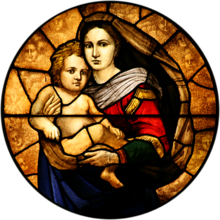Mariolojia ya Kianglikana

Mariolojia ya Kianglikana inajumlisha mitazamo mbalimbali ya theolojia ya Wakristo wa Ushirika la Anglikana kuhusu Bikira Maria, Mama wa Yesu.
Hadi sasa Ushirika wa Anglikana unashika mafundisho ya mapokeo yaliyotolewa na mitaguso ya kiekumeni na baadhi humheshimu Bikira Maria [1] kuliko namna inavyokubaliwa na baadhi ya wenzao na Waprotestanti, hasa ya madhehebu yaliyoanzishwa Marekani katika karne za mwisho[2][3]
Katika Majadiliano ya kiekumeni kuhusu Maria Waanglikana na Wakatoliki waliweza kukubaliana kwa kiasi kikubwa sana[4].
Tanbihi[hariri | hariri chanzo]
- ↑ Summary: *Anglicans recognize the dogma upheld at the Council of Ephesus (431) and the Council of Chalcedon (451) that Mary is the Theotokos, the "God-Bearer". The reason Anglicans accept this statement is because it is primarily a Christological affirmation, affirming that Christ is God. The terms "Mother of God" and "God-Bearer," however, are not used in the official formularies of the Churches of the Anglican Communion, and some Anglicans would not wish to use these terms.
- Some Anglicans agree that the doctrine of the perpetual virginity of Mary is sound and logical, but without more scriptural proof it cannot be considered dogmatic.
- No Anglican denomination accepts belief in Mary as Co-Redemptrix and any interpretation of the role of Mary that obscures the unique mediation of Christ.
- Anglicans typically believe that all doctrines concerning Mary must be linked with the doctrines of Christ and the Church.
- Anglicans recognize Mary as an example of holiness, faith and obedience for all Christians; and that Mary can be seen as a prophetic figure of the Church. As the Gospel of Luke (1.48) states "henceforth all nations shall call me blessed," she is often considered to have a unique place of importance within the Communion of Saints
- Churches of the Anglican Communion observe at least some of the traditional Marian festivals of the ancient Catholic Church. The Church of England, for example, in the Calendar of its 1662 Book of Common Prayer includes The Annunciation of our Lady on March 25 as a festival to be observed. That Calendar includes as "black-letter days" the Conception, the Nativity, and the Visitation of the Blessed Virgin Mary, but does not observe them liturgically. Some later Prayer Books e.g., the 1991 Anglo-Catholic Anglican Service Book, do allow them to be so observed and may even publish certain Marian devotions, and most recent Anglican Prayer Books include St Mary the Mother of the Lord as a major festival on August 15.
- ↑ The Everything Jesus Book: His Life, His Teachings by Jon Kennedy 2006 ISBN|1-59337-712-6 page 7
- ↑ Walsingham in Literature and Culture from the Middle Ages to Modernity by Dominic Janes, Gary Fredric Waller 2010 ISBN|0-7546-6924-6 pages 12–13
- ↑ "Mary: Grace and Hope in Christ"
Viungo vya nje[hariri | hariri chanzo]
- "Mary: Grace and Hope in Christ" - Final document from ARCIC II on Mary

